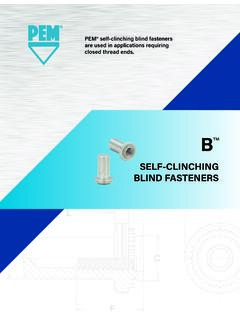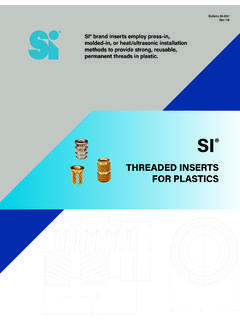Transcription of The Self-clinching Fastener Handbook - PennEngineering
1 TheSelf-clinchingFastenerHandbookHandboo k-618HB-2 PennEngineering Fastener history .. 3 How, why and where Self-clinching works .. 4 Reliability in service .. 5 Anatomy of Self-clinching .. 6 Types of Self-clinching fasteners .. 7 Importance of quality .. 8 Installation procedure .. 9 Installation problems and solutions .. 10-11 Common Design Challenges .. 12 Other considerations .. 13 Questions and Answers .. 14 Glossary of terms .. 15 Identification Trademarks .. 16contents 2018 is a brand name and a registered trademark for fasteners manufactured exclusively by HB-3hen Swanstrom founded Penn Engineering & Manufacturing Corp.
2 In 1942, he did so with a revolutionary new product: an easy-to-install, Self-clinching Fastener that provides load-carrying threads in metal sheets too thin to be first, Mr. Swanstrom produced his innovative design with four machines in a Doylestown, Pennsylvania garage. This simple operation soon gave way to a modern facility in Danboro, Pennsylvania as manufacturers and engineers alike recognized the benefits of Self-clinching fasteners. They not only reduced time, labor, weight and inventory on many assembly jobs, but they also opened up a whole new world for engineers and designers, making a wide assortment of thin-metal designs possible for the first acceptance led to earnest production of Self-clinching fasteners shortly after World War II.
3 As industry s need to hold together ultra-thin and ultra-light metals grew, so did the product line. Over the years the original Self-clinching Fastener design evolved to meet hundreds of new design , nuts, studs, spacers, standoffs, access hardware, and other components are used worldwide by a variety of manufacturers, including producers of telecommunication, computer, medical, automotive, and aerospace equipment and of Self-clinching fasteners: Provide strong threads in metal as thin as .012 mm. Installs into a plain, round hole. Installed using any parallel acting squeezing force. Provide high pushout and torque-out resistance.
4 Do not require special hole preparation, such as chamfering and deburring. Reverse side of metal sheet remains flush. No retapping necessary after application. Low installed ideathat revolutionizedproduction fasteningwHB-4 PennEngineering defined, a Self-clinching Fastener is any device, usually threaded, that when pressed into ductile metal, displaces the host material around the mounting hole, causing it to cold flow into a specially designed annular recess in the shank or pilot of the Fastener . A serrated clinching ring, knurl, ribs, or hex head prevents the Fastener from rotating in the host material once it has been properly inserted (see page 6).
5 Thus, Self-clinching fasteners become a permanent part of the panel, chassis, bracket, or other item into which they are also have greater reliability and more holding power than extruded/tapped or stamped threads. They are used chiefly where good pullout and torque loads are required in sheet metal that is too thin to provide secure fastening by any other method. Even if the sheet is thick enough to sustain tapping, it may actually be more economical to use Self-clinching fasteners with gaugeable threads. They can be installed during fabrication to eliminate loose hardware during final assembly. In fact, the use of Self-clinching fasteners often will allow the use of a thinner sheet.
6 Because of their compact design and low profile, they provide for a neat appearance, a rule, a Self-clinching Fastener should be specified whenever a component must be readily replaced and where loose nuts and hardware won t be accessible. If it appears that the attaching nuts and screws can t be reached after a chassis or cabinet is assembled, Self-clinching fasteners can be installed during metal fabrication and can simplify and expedite component mounting and assembly operations, including those performed in the NOTE FOR INSTALLING INTO STAINLESS STEEL SHEETSOne of the very basics of Self-clinching is that the Fastener must be harder than the host sheet.
7 Only then will the Fastener perform as intended. This is particularly challenging when installing fasteners into stainless steel sheet your application requires that the Fastener clinches into stainless steel, be sure you use the fasteners specifically designed for this purpose. Consult PEM Bulletin SS for information on these types of FOR MANUFACTUREAND ASSEMBLY Self-clinching fasteners help designers meet DFMA parameters which include: Fewer parts to handle. Hardware such as washers, lock washers, and loose nuts are no longer required in final assembly. Fewer assembly steps. Since the task of hardware installation is done during fabrication, the number of steps required for final assembly is reduced.
8 Less total assembly time. Fewer parts and less steps mean shorter assembly of which lead to shorter time to market, improved quality through assembly simplification, and reduced REQUIRE: Ductile panel material softer than the Fastener . (Generally a 20 point difference on the Rockwell B scale is required). See tables on page 6. Adequate sheet thickness. Pre-punched holes. Access to both sides of the sheet for installation. An insertion press with adequate throat depth to reach the installation these conditions can be met, then Self-clinching fasteners are the best solution for strong, clean, permanent threads in thin sheet metal.
9 If material is not ductile enough, see Fasteners for Non-ductile Materials on page , why & whereto use Self-clinching fastenersbPennEngineering HB-5he reliability of a Self-clinching Fastener in service depends on many factors, beginning with a properly sized hole, the thickness and hardness of the host panel, proper installation and design of the Fastener , and the application where the Fastener is are three tests applicable to a Self-clinching Fastener to determine its reliability in service. The first, called torque-out, determines the Fastener s ability to resist rotation within the panel. This test often is made at the head of the Fastener often with values exceeding the ultimate torsional strength of the mating screw or second reliability measure is pushout.
10 Pushout values indicate the axial resistance of a Fastener to remove it from the sheet opposite to the direction from which it was installed, and should be roughly 5 to 10% of the force used to install the final test is pull-through.(1) Pull-through is the resistance of a Fastener to pulling through the metal sheet when a clamping torque is applied.(1) Pull-through generally applies only to Self-clinching studs and standoffs and is not shown in this chart.(2) See special note about installing into stainless steel on page 4. Test Sheet Material Thread Type S Nut Installed Into Type S Nut Installed Into Type SP Nut Installed Into Size 5052-H34 Aluminum Cold-rolled Steel 300 Series Stainless Steel(2) Installation Pushout Torque-out Installation Pushout Torque-out Installation Pushout Torque-out (lbs.)










